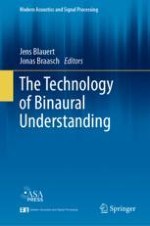2020 | OriginalPaper | Buchkapitel
Binaural Technology for Machine Speech Recognition and Understanding
verfasst von : Richard M. Stern, Anjali Menon
Erschienen in: The Technology of Binaural Understanding
Aktivieren Sie unsere intelligente Suche, um passende Fachinhalte oder Patente zu finden.
Wählen Sie Textabschnitte aus um mit Künstlicher Intelligenz passenden Patente zu finden. powered by
Markieren Sie Textabschnitte, um KI-gestützt weitere passende Inhalte zu finden. powered by
